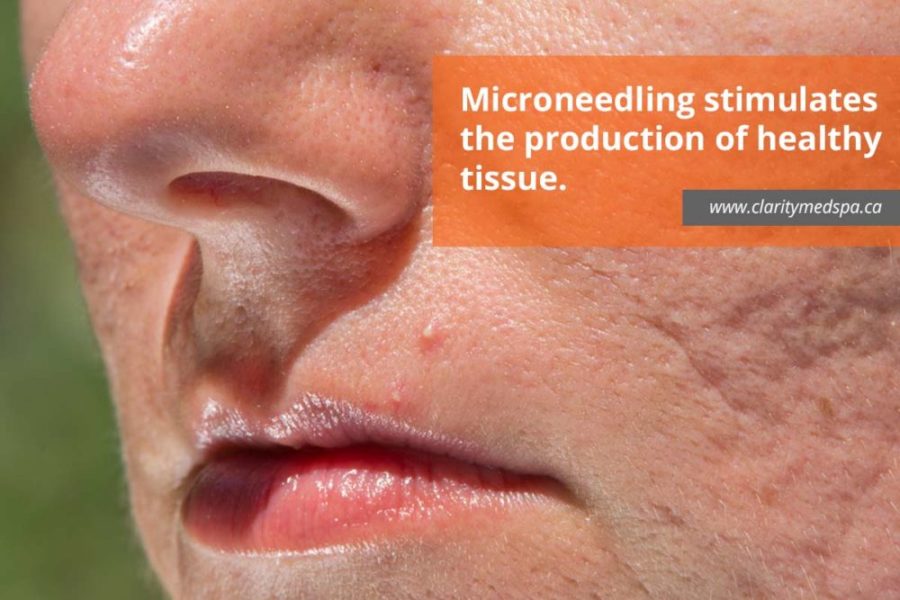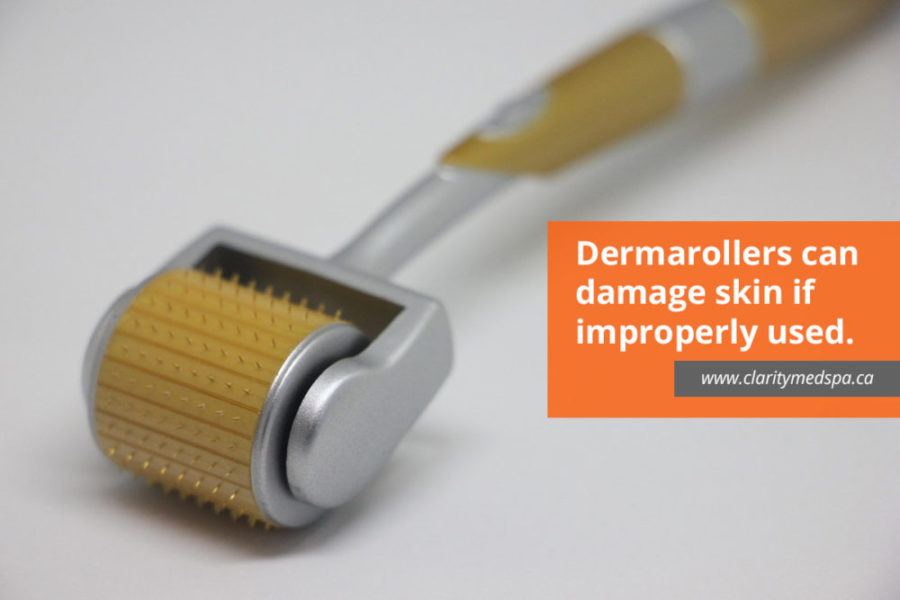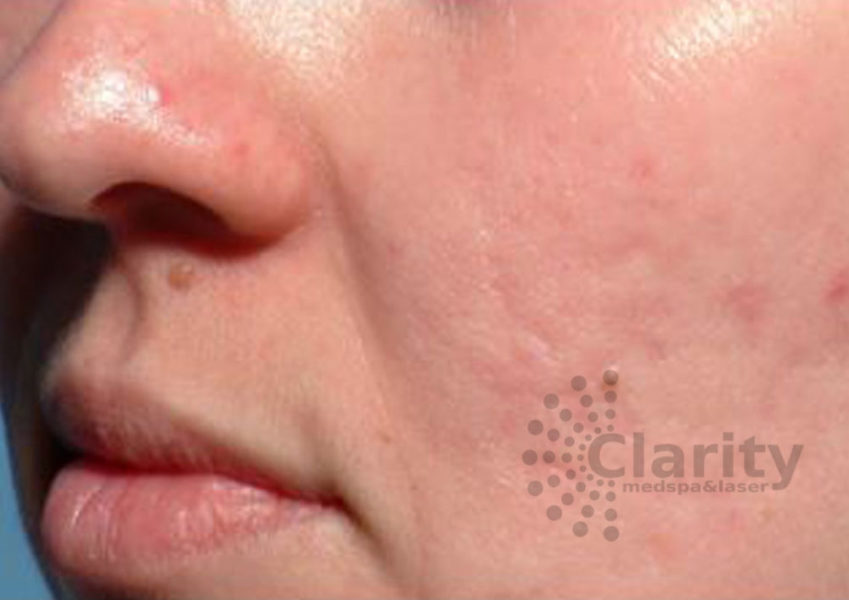Microneedling for acne scars—Does it work?
With so much choice in the aesthetics & medspa industry, it can be overwhelming when trying to find the skin treatment that’s best for you, especially when trying to resolve acne scars.
So how do you know which acne scar treatment to pick?
Which scar treatment will give you the most bang for your investment?
Who should you turn to?
Popular for a range of skin concerns, microneedling has proven safe and effective for issues related to aging. The question is: “Is this really the best treatment for acne scars? Could this make my scarring worse?”
In this post, we are giving you an overview of acne scar treatments so that you can make informed decisions regarding laser treatments and acne care.
What Is Microneedling and how does it work?

As the name suggests, Microneedling is a procedure that uses tiny needles to create micro-injuries in the skin. The purpose of these tiny micro-wounds is to trigger the skin’s own healing response. While this might sound daunting (treatment involves a topical numbing cream) microneedling is virtually painless.
Treatments can come in the form of spa grade pen-like tools such as Dermapen or Medical Devices that include radiofrequency (RF). Common to both options is the use of tiny needles to help awaken collagen production which plays a vital role in the skin’s healing process. By creating superficial wounds (short term injury), the skin is tricked into repairing and regenerating itself.
Does microneedling help with acne scars?
This is a common question and requires an explanation regarding the differences between textural acne scars and hyperpigmented scars.
True acne scars appear as indentations and are usually caused by cystic or nodular acne (deeply embedded pimples that don’t come to a head, inflamed and are often painful). Squeezing and picking at deep pimples increases the likelihood of blemishes and atrophic (indented) scars that can linger for years, or worse, never resolve at all.
To avoid scarring consult with a medical aesthetic professional about products you can use at home to help reduce breakouts and better support the skin.
PIH (post-inflammatory hyperpigmentation) is the technical term for dark marks and brownish blemishes that hang around long after a pimple has come and gone. People often talk about PIH and indented acne scars interchangeably, but for the sake of this post, it’s important to distinguish the difference between the two.
Microneedling for indented acne scars

The good news is that microneedling can absolutely help with indented acne scars by stimulating the production of collagen to plump or “fill out” them out. It is through the production of new collagen that the skin will have an overall smoother appearance. Basically, microneedling creates micro-channels of tissue destruction that “turns over” and is eventually replaced by new healthy tissue.
Medical-grade micro-needling devices with built-in RF are most effective and considered a gold standard option. According to Chantal Ward, RN “While Fraxel™️ for acne scars was once our most common treatment for textured acne scars, my preference now is to microneedle with technology that includes Radio Frequency (RF). RF takes microneedling for acne scars to another level as it helps stimulate the dermis to become thicker and to compensate for atrophic or dented acne scars.. not to mention the downtime is almost zero.”
MicroNeedling with RF (vs spa-grade Pen Treatments) helps build collagen and elastin since it penetrates optimal depthas, for an overall tighter, firmer result. When combined with Radio Frequency, this combination offers consistent and more predictable results.
Microneedling for hyperpigmentation
While some spas recommend microneedling for PIH (post inflammatory hyperpigmentation) there are better treatment options. PIH is caused by an excess of melanin – in essence overactive pigment cells are triggered by the trauma of an inflamed blemish or pimple to create a blemish. When discolouration occurs, the goal is to calm (vs excite) the overactive pigment cells. Because of this, microneedling can be tricky as it has the potential to overstimulate, causing the cells to overreact. Understanding the potential risk of overstimulation, it is prudent to pre-treat the skin with skin care that suppresses melanin production prior to any laser.
If you’re looking to lighten brown acne scars, carefully curated medical-grade chemical peels can be highly effective. That said, be prepared for the long game — it’s all about patience, a mindful treatment plan and, of course, sun protection.
Can microneedling make acne scars worse?
If you have raised scars, hypertrophic scars (or keloids) caused by an overproduction of collagen during the healing process, microneedling is not recommended. Since collagen excess is already the issue, you want to stay away from procedures that trigger further collagen production. It is best to speak to your medical practitioner who fully understands all laser options for the best approach.
At-Home treatments for acne scarring
Sadly, Microneedling is not available to everyone. Fortunately, there are things you can do at home to smooth the skin and minimize brown spots. With or without microneedling, including any of these steps will benefit you.
Topical Treatments
As far as topical treatments go, these are best for building and protecting collagen.
- RetinoidsRetinoids can be found in prescription-strength products that you’ll need to have scripted.For those with sensitive skin, you may prefer a gentler approach. Look for formulations sold over the counter that contain retinol. For those wanting a plant-based formula, look for Bakuchiol.
- Antioxidants, Vitamin C, and Other Nutrients Antioxidants not only help build collagen they also repair and prevent it from being broken down further by combatting free radicals.If unaddressed or repaired imperfectly, free radicals accumulate over time, giving rise to wrinkles, brown spots, and skin cancers. Breakthroughs in skin care technology have resulted in super Serums blended specifically for accelerated defence.
- Exfoliating AcidsExfoliating acids can help plump the skin by building collagen, but they also help give the skin a more even-textured appearance by “sanding down” the top layers of dead skin cells.
- SunscreenThe sun’s rays contribute to the breakdown of collagen more than any other external factor, so wearing a broad-spectrum sunscreen every day is crucial.
While home care can help minimize the appearance of indented acne scars, keep in mind that results will not be as effective as a professional treatment. It’s important to manage your expectations and be wary of claims stating that a single product will offer a cure.
At-Home microneedling

Thanks to social media, you may have noticed at-home microneedling devices (e.g. dermarollers) showing people blissfully rolling needles across their faces.
“This makes us cringe every time” says Ms. Ward. “It is our belief that microneedling of any kind should be left to professionals as there is great potential for damaging your skin.”
Bottom Line — get trusted advice for acne scars.
With many options for treating acne scars, it’s important to schedule a consultation with a professional who is well versed in all options and able to discuss what is best for your unique situation. Microneedling is well-documented and the science supports that it is as an effective treatment for indented acne scarring, especially when combined with RF.
To book your micro needling consultation for acne scars or anti-aging contact Clarity Medspa & Laser Centre in Toronto (416) 988-1010.


 Linkedin
Linkedin Facebook
Facebook  Instagram
Instagram  Twitter
Twitter  Youtube
Youtube